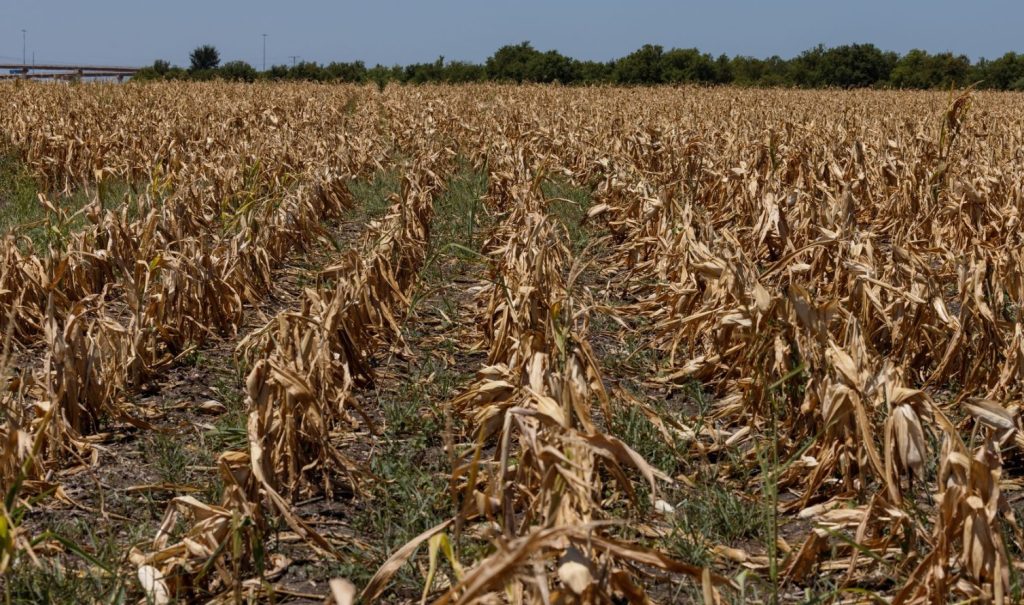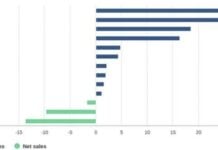
Scorching temperatures this past week have put swaths of the U.S., especially in the South and West, under excessive-heat warnings and advisories. The hot weather is hitting during an important period of the Midwest crop-growing season, analysts said, and just as some commodity prices ease amid concerns about global food supplies.
The heat is also exacerbating longer-running drought conditions in parts of Kansas, Oklahoma, Texas and other states, risking harm to livestock, parching pastures and leading ranchers to spend more on supplemental feed for cattle.
EMP Shield: Best protection against lightnings, EMP and solar storms events at discount price!…
In Iowa, which produces more corn than any other U.S. state, temperatures are forecast to hit 100 degrees in the western part of the state, according to the National Weather Service. Major livestock-producing states, including Texas and Oklahoma, are expected to see temperatures hit 104 degrees over the weekend. Some places in the region have had extremely hot and dry weather for prolonged periods.
Charlie Swanson, a third-generation cattle producer outside Roosevelt, Okla., said temperatures have climbed over 100 degrees every day since the start of the month, including a 114-degree day on Tuesday. Combined with scant rain, the heat is roasting his pastures, cutting into the grass and forage he raises to graze his cattle.
Recent high temperatures are particularly difficult for states experiencing drought conditions, such as Oklahoma. Ranchers in the region were already paying more for feed, fertilizer, fuel and other expenses, and are selling their calves into feedlots at a faster pace, according to Agriculture Department data. Mr. Swanson said his feed costs have climbed by roughly $100 a ton from a year ago, while fertilizer also has grown more expensive.
Never be in the dark again with this portable solar power station!
Mr. Swanson recently sold 80 of his cows to a beef packer in Texas because it was getting too expensive to keep feeding them, he said.
During a drought, he said, ranchers often cull their less-productive cows that may cost more to feed.
“Everybody is cutting back on expenses if they can,” Mr. Swanson said.
The prices that ranchers receive for their cattle have climbed roughly 15% from a year ago, according to the USDA, but producers are still struggling to break even. Prices for hay, which is widely used to feed cattle, were 56% higher in April than in 2021, according to a June report from the Federal Reserve Bank of Kansas City. Cattle producers are estimated to have lost money the past two months, according to a cost-and-return analysis from Iowa State University.
High temperatures also pose health risks for farm animals. Thousands of cattle in Kansas died in June as a result of excessive heat. In poultry, rolling blackouts and brownouts because of high temperatures in Southeastern states have been a concern for growers, who must constantly ventilate and cool their barns.
Panorama Organic Grass-Fed Meats, a division of poultry company Perdue Farms Inc., is trying to help ranchers move their cattle from drought-ridden states, said Kay Cornelius, Panorama’s general manager. For example, the company might connect a rancher in Bakersfield, Calif., who is struggling with dry weather with a producer in Nebraska looking to buy cattle. “We’re the matchmaker,” she said.
If the high heat persists in certain areas of the country and this year’s corn crop starts to take a hit, it could drive feed costs higher still for livestock producers, industry analysts say.
Stock up on Iodine tablets for the next nuclear disaster…
Eddie Sanders, a fourth-generation corn grower in Franklin, Tenn., said he expects to harvest only roughly one-third to one-half of his corn crop this year, because of the hot and dry weather. He said he is hoping to be able to salvage his soybean crop, but if the hot weather persists into August, that too might be at risk.
“We’re burned up here,” he said. “We’re at the mercy of a rain every 10 days.”
Many Midwestern farms got a late start planting corn and other cropsbecause of a wet spring. In some areas, it is now too dry. Nearly 30% of U.S. corn production and 26% of soybean production are in areas experiencing drought, according to the U.S. Drought Monitor.
Drink clean water at home… Get this filter now…
Corn is now pollinating in many parts of the grain belt, a time when the plants require the most water. Serious drought and heat stress during corn pollination can translate to yield losses of about 9% a day, said Dan Quinn, an agronomist at Purdue University and corn specialist who works with regional farmers.
Some analysts and traders said crops remain in good shape. Big farm states including Illinois, Indiana and parts of Iowa have received rain recently, and the USDA’s crop report on July 18 showed steady corn conditions.
In Canada too:
Corn futures prices at the Chicago Board of Trade have traded nearly 7% lower over the past week. Rainfall is in the forecast for parts of the Midwest next week, which should ease some crop concerns, analysts said.
Health Ranger Store: Buy Clean Food to heal yourself and the world…
Prices for agricultural commodities including corn and wheat have tumbled in recent weeks, following a monthslong surge touched off by Russia’s invasion of Ukraine in late February.
Food and agriculture officials have warned that global grain supplies remain at risk, especially as poor weather casts uncertainty over important crop-growing regions.
An abundant harvest would help ease concerns over global food supplies, but the U.S. is likely to face more yield-damaging heat this month, said Jon Davis, chief meteorologist at Everstream Analytics, a supply-chain risk-management company. Corn in the pollination stage begins to be stressed to the point of yield losses when temperatures exceed the mid-90s for several days with no relief during the night, he said. [Fox]
StrangeSounds.org has been banned from ad networks and is now entirely reader-supported CLICK HERE TO SUPPORT MY WORK… I will send you a small gemstone if you give more than 25$… Thanks in advance!
Here some things to add to your disaster & preparedness kit:
- Protect your home and car with the best EMP, solar flares and lightning shield available…
- Drink clean water at home… Get this filter now…
- Health Ranger Store: Buy Clean Food and Products to heal the world…
- Prepare your retirement by investing in GOLD, SILVER and other PRECIOUS METALS…
- You will ALWAYS have electricity with this portable SOLAR power station…
- Qfiles is another great site for alternative news and information…














All man made heat waves via HAARP. They started with cloud seeding decades ago. That part is totally public and out in the open. Then they added cloud making with releasing tons of moisture up in the air, that can be seen online and at weather sites. Then they went to HAARP, an atmosphere HEATER, they admit it is a HEATER, presto.. HEAT WAVES on demand. God will judge these demonic and insane creatures, eventually.
My dad told me that when he was a boy during the 1920s that it got so hot that the corn popped in the field. The cows thought it was snow, laid down in it and froze to death. Many farmers lost everything that year.
Heck, there’s no sign of drought here in the mountains. It’s thunder and lightning. Rained probably 1″ earlier, and now light but steady. Radio—Severe weather alerts for flash flooding etc…beeep, beeep, beeep. Lol
My crops are small time, so I can do fine with chicken goose, duck manure, organic mulch, kitchen organic waste. I don’t go for chemical fertilzers. If I want extra nitrogen I can take a leak on a two year old tree to kick it up to speed. Most everything I grow seems to do well, except my elderberry this year, but they didn’t do well here in my zone.
We just had reports that the areas where flash flooding is likely hit near creeks and washes that feed the Colorado river. So, that’s good news.
Day 3 of storms. Duck pond is almost half full. Huge pools of water in low lying areas. No drought in sight.
We know that weather has and can be manipulated—the technology has been there since the 40’s.
Silver iodide was used to create rain decades ago—I am sure that different methods exist now to do that.
Must be a reason why it’s not being done (or maybe it has—and that’s why we have these conditions now).
Good point John,
Weather can be manipulated. Let’s see some weather HAARP magic, or seeding. Maybe our government lackeys can actually do something beneficial for the poor ranchers and farmers for a change, instead of trying to screw them off their land and build rapefugee camps, or grow GMO shitcrops.
Go to YouTube. Watch Gabe Brown explain why his neighboring ranchers are on aggie welfare while he hauls in bumper crops on 16 inches of moisture a year. I remember Dad getting a lecture to by Grampa and my great-grandfather when he planted hybrids instead of open-pollinated corn. He got it for buying fertilizer, as well, instead of raising his own (cover crops, if grazed will make 3 times and more of fertilizer). What fool pays for nitrogen when God put 10 miles of it over every acre on earth?